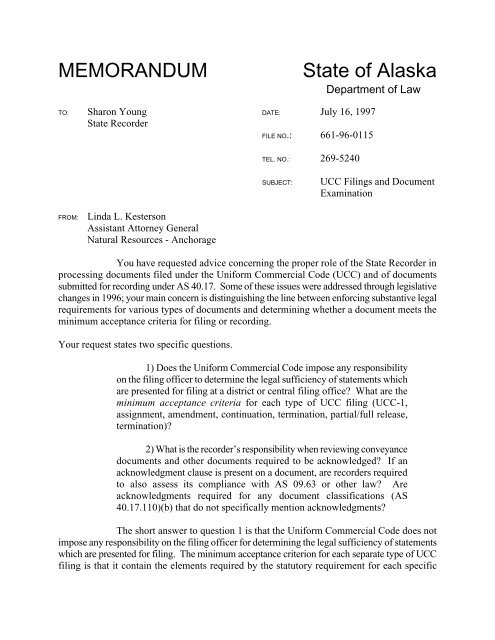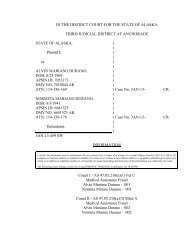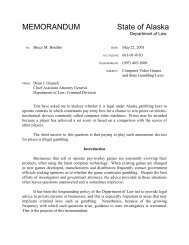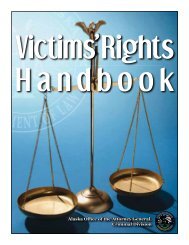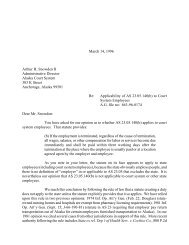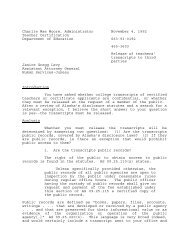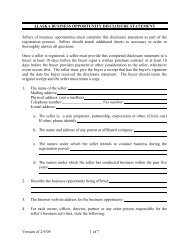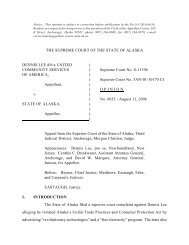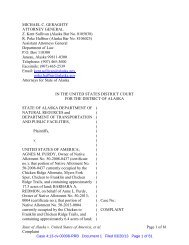UCC Filings and Document Examination - Alaska Department of Law
UCC Filings and Document Examination - Alaska Department of Law
UCC Filings and Document Examination - Alaska Department of Law
You also want an ePaper? Increase the reach of your titles
YUMPU automatically turns print PDFs into web optimized ePapers that Google loves.
MEMORANDUM<br />
State <strong>of</strong> <strong>Alaska</strong><br />
<strong>Department</strong> <strong>of</strong> <strong>Law</strong><br />
TO:<br />
Sharon Young<br />
State Recorder<br />
DATE:<br />
FILE NO.:<br />
July 16, 1997<br />
661-96-0115<br />
TEL. NO.: 269-5240<br />
SUBJECT:<br />
<strong>UCC</strong> <strong>Filings</strong> <strong>and</strong> <strong>Document</strong><br />
<strong>Examination</strong><br />
FROM:<br />
Linda L. Kesterson<br />
Assistant Attorney General<br />
Natural Resources - Anchorage<br />
You have requested advice concerning the proper role <strong>of</strong> the State Recorder in<br />
processing documents filed under the Uniform Commercial Code (<strong>UCC</strong>) <strong>and</strong> <strong>of</strong> documents<br />
submitted for recording under AS 40.17. Some <strong>of</strong> these issues were addressed through legislative<br />
changes in 1996; your main concern is distinguishing the line between enforcing substantive legal<br />
requirements for various types <strong>of</strong> documents <strong>and</strong> determining whether a document meets the<br />
minimum acceptance criteria for filing or recording.<br />
Your request states two specific questions.<br />
1) Does the Uniform Commercial Code impose any responsibility<br />
on the filing <strong>of</strong>ficer to determine the legal sufficiency <strong>of</strong> statements which<br />
are presented for filing at a district or central filing <strong>of</strong>fice? What are the<br />
minimum acceptance criteria for each type <strong>of</strong> <strong>UCC</strong> filing (<strong>UCC</strong>-1,<br />
assignment, amendment, continuation, termination, partial/full release,<br />
termination)?<br />
2) What is the recorder’s responsibility when reviewing conveyance<br />
documents <strong>and</strong> other documents required to be acknowledged? If an<br />
acknowledgment clause is present on a document, are recorders required<br />
to also assess its compliance with AS 09.63 or other law? Are<br />
acknowledgments required for any document classifications (AS<br />
40.17.110)(b) that do not specifically mention acknowledgments?<br />
The short answer to question 1 is that the Uniform Commercial Code does not<br />
impose any responsibility on the filing <strong>of</strong>ficer for determining the legal sufficiency <strong>of</strong> statements<br />
which are presented for filing. The minimum acceptance criterion for each separate type <strong>of</strong> <strong>UCC</strong><br />
filing is that it contain the elements required by the statutory requirement for each specific
Sharon Young July 16, 1997<br />
State Recorder Page 2<br />
A.G. file no: 661-96-0115<br />
document; the filing <strong>of</strong>ficer does not have responsibility to determine whether or not the elements<br />
required for the document have been properly completed.<br />
The short answer to question 2 is that when reviewing conveyance documents that<br />
require an acknowledgment, it is the recorder’s responsibility to determine that an<br />
acknowledgment statement is present. If an acknowledgment clause is present on the document<br />
the recorder has no responsibility to assess the acknowledgment clause’s compliance with AS<br />
09.63 or any other law. Under AS 40.17.110 as amended in 1996, acknowledgments are only<br />
required if the document to be recorded is a conveyance, power <strong>of</strong> attorney, contract for the sale<br />
or purchase <strong>of</strong> real property, option for the purchase <strong>of</strong> real property, or a subdivision plat. These<br />
conclusions are addressed more fully below.<br />
I. <strong>UCC</strong> FILINGS<br />
The particular issue <strong>of</strong> the scope <strong>of</strong> the duties <strong>of</strong> the recorder’s <strong>of</strong>fice to examine<br />
documents for filing has not been directly addressed by the courts. The courts, not only in <strong>Alaska</strong><br />
but nationwide, are called on frequently to determine whether a particular document filed under<br />
the provisions <strong>of</strong> the <strong>UCC</strong> is legally sufficient for its purported purpose; however, that is a<br />
conclusion <strong>of</strong> law <strong>and</strong> the recorder has no authority to render such conclusions. This does not<br />
mean, however, that any document provided for filing which states that it is a financing statement<br />
is to be filed <strong>and</strong> indexed as a financing statement pursuant to the <strong>UCC</strong>.<br />
An extensive memor<strong>and</strong>um <strong>of</strong> advice was prepared on June 14, 1979, to Julius<br />
Brecht, who was then director <strong>of</strong> the <strong>Department</strong> <strong>of</strong> Commerce <strong>and</strong> Economic Development,<br />
Division <strong>of</strong> Banking, Securities <strong>and</strong> Corporations. 1 This memor<strong>and</strong>um <strong>of</strong> advice extensively<br />
documents various attorney general opinions <strong>and</strong> case law up to the date <strong>of</strong> the memor<strong>and</strong>um <strong>and</strong><br />
the analysis reflected therein is still valid. Although the particular conclusion in that<br />
memor<strong>and</strong>um <strong>of</strong> advice is very specific <strong>and</strong> deals with the presence <strong>of</strong> an original signature on<br />
a financing statement, its analysis is a helpful background. A copy is attached for your reference.<br />
In pertinent part, the conclusion <strong>of</strong> the above-referenced memo states:<br />
Finally, we believe that the filing <strong>of</strong>ficer has the statutory<br />
responsibility to review documents <strong>of</strong>fered for filing as financing<br />
statements. Only those writings that reflect the basic <strong>and</strong> simple<br />
1<br />
<strong>Alaska</strong> U.C.C. Requirement That Debtors Sign The Financing Statement, Inf. Op. Att’y Gen.,<br />
June 14, 1979, File J-66-086-79. At the time this MOA was written, the responsibility for the filing<br />
<strong>of</strong> <strong>UCC</strong> documents was within the <strong>Department</strong> <strong>of</strong> Commerce <strong>and</strong> Economic Development. These<br />
duties were transferred to the <strong>Department</strong> <strong>of</strong> Natural Resources in 1980. See, Exec. Order No. 47<br />
(1980).
Sharon Young July 16, 1997<br />
State Recorder Page 3<br />
A.G. file no: 661-96-0115<br />
requirements <strong>of</strong> § 9-402 qualify as financing statements <strong>and</strong> only those that<br />
qualify may be filed <strong>and</strong> thus afforded the protection <strong>of</strong> the system.<br />
However, once a filing <strong>of</strong>ficer ascertains that the writing is a financing<br />
statement, § 9-403 unambiguously states that the “[P]resentation for filing<br />
<strong>of</strong> a financing statement <strong>and</strong> tender <strong>of</strong> the filing fee . . . constitutes filing<br />
under this Article.” It is thus clear that the filing <strong>of</strong>ficer’s discretionary<br />
authority to determine qualification for filing does not extend to the actual<br />
ministerial act <strong>of</strong> filing. At this stage the filing <strong>of</strong>ficer has ceased to be<br />
involved in the realm <strong>of</strong> discretion <strong>and</strong> serves only as a ministerial<br />
functionary. The document must be filed.<br />
Inf. Op. Att’y Gen., June 14, 1979, File J-66-086-79, at 27. 2<br />
In your memor<strong>and</strong>um requesting advice on this issue it is clear that the major<br />
concern <strong>of</strong> the recorder’s <strong>of</strong>fice is that it not be put in a position <strong>of</strong> <strong>of</strong>fering legal advice as to the<br />
legal sufficiency <strong>of</strong> documents provided for filing. This is an underst<strong>and</strong>able concern <strong>and</strong> it is<br />
necessary to carefully distinguish between basic criteria which identify a document as one that is<br />
to be filed <strong>and</strong> those which are necessary for a legal determination <strong>of</strong> whether the document is<br />
sufficient to meet its legal purpose. This is the distinction you have made in your memor<strong>and</strong>um<br />
between the requirements for filing <strong>and</strong> the requirements for perfection.<br />
The difficulty in drawing the line between the requirements for filing <strong>and</strong> the<br />
requirements for perfection is that one <strong>of</strong> the main purposes <strong>of</strong> the Uniform Commercial Code<br />
was to establish a system whereby there would be a notice <strong>of</strong> filing; that is, the act <strong>of</strong> filing a<br />
document would put others on notice that a security interest exists. It is, however, a legitimate<br />
concern that the recorder’s <strong>of</strong>fice not be placed in the position <strong>of</strong> determining for people who are<br />
filing various documents to perfect security interests whether or not those documents are actually<br />
sufficient for that purpose. In one <strong>of</strong> the st<strong>and</strong>ards texts concerning the law <strong>of</strong> secured<br />
transactions, the author has stated:<br />
In addition to accepting payment <strong>of</strong> the proper fee, the filing <strong>of</strong>ficer<br />
must examine the financing statement or other document to make sure that<br />
it meets the minimal requisites <strong>of</strong> Article 9. Although some secured<br />
parties might call this the unauthorized practice <strong>of</strong> law, rejection by the<br />
2<br />
At the time <strong>of</strong> the memor<strong>and</strong>um <strong>of</strong> advice the <strong>UCC</strong> provisions were found at AS 45.05.<br />
Subsequent to the memor<strong>and</strong>um <strong>of</strong> advice, the Uniform Commercial Code provisions were amended<br />
including adoption <strong>of</strong> the 1972 revised code <strong>and</strong> subsequent changes. The changes are not relevant<br />
to the current analysis on this particular issue. The provisions dealing with the filing <strong>of</strong> secured<br />
interests are now found at AS 45.09.401 through AS 45.09.408.
Sharon Young July 16, 1997<br />
State Recorder Page 4<br />
A.G. file no: 661-96-0115<br />
filing <strong>of</strong>ficer can <strong>of</strong>ten bring an error to the secured parties’ attention<br />
before real harm occurs. Reasons for rejection, for example, might include<br />
a lack <strong>of</strong> the debtor’s signature or address, or both; lack <strong>of</strong> the secured<br />
party’s name or address, or both; failure to describe the collateral; lack <strong>of</strong><br />
a necessary real estate description requiring cross-indexing (as with a<br />
fixture filing); absence <strong>of</strong> a required tax identification number as required<br />
in some states; or illegibility that could lead to indexing errors.<br />
Barkley Clark, THE LAW OF SECURED TRANSACTIONS UNDER THE <strong>UCC</strong>, revised ed. (1993) at<br />
2.17[2] at 2-177.<br />
In practical terms this means that the recorder’s <strong>of</strong>fice has a responsibility to<br />
determine whether a paper presented for filing meets the technical requirements set out in the<br />
statute for a document <strong>of</strong> that type. It does not mean that the recorder’s <strong>of</strong>fice is to critically<br />
examine the information provided in the necessary elements; it means that the recorder’s <strong>of</strong>fice<br />
is to determine that the necessary elements are there so that it meets the definition <strong>of</strong> the particular<br />
document as required in the statute. Once that determination has been made, the document is to<br />
be filed <strong>and</strong> indexed. If it is not clear from the face <strong>of</strong> the document the purpose for which it is<br />
to be indexed, it is the responsibility <strong>of</strong> the person filing it to inform the recorder’s <strong>of</strong>fice what<br />
the document is.<br />
The technical requirements for the various security interest documents that will be<br />
presented for filing are found in article 4 <strong>of</strong> the <strong>UCC</strong>; this has been enacted in <strong>Alaska</strong> as AS<br />
45.09.401 through AS 45.09.408. At 45.09.402(c), the statute sets forth a form listing the<br />
required elements for a 402(a) statement. The financing statement need not be in the exact form<br />
presented, but the form gives an example <strong>of</strong> a form that would contain all the necessary elements.<br />
The department has the authority to provide a st<strong>and</strong>ard form that may be used by creditors to file<br />
their security interest. Creditors are not required to use a st<strong>and</strong>ard form provided by the<br />
department, but if they use a form other than one provided by the department, the department is<br />
authorized to charge an additional fee. See AS 45.09.403(e). The specific authority for the<br />
department to establish an extra uniform fee for statements not in the st<strong>and</strong>ard form prescribed<br />
by the department also exists for termination statements (AS 45.09.404(c)); for an assignment <strong>of</strong><br />
security interest (AS 45.09.405(a)); <strong>and</strong> for a release <strong>of</strong> collateral (AS 45.09.406).<br />
The recorder’s <strong>of</strong>fice has no authority to determine whether or not a document<br />
presented by a creditor is legally sufficient. It has the duty <strong>and</strong> responsibility to file <strong>and</strong> index the<br />
documents presented for filing pursuant to the <strong>UCC</strong> provisions. If there is an “obvious error” this<br />
should be brought to the attention <strong>of</strong> the filer. As the recorder cannot make legal or judicial<br />
interpretations <strong>of</strong> a document, these “obvious errors” are limited to the absence <strong>of</strong> a necessary<br />
element or errors <strong>of</strong> the type that might lead to improper indexing. For instance, if more than one
Sharon Young July 16, 1997<br />
State Recorder Page 5<br />
A.G. file no: 661-96-0115<br />
version <strong>of</strong> the debtor’s name appears on the form, the filing <strong>of</strong>ficer would need guidance as to<br />
which name the document should be indexed under.<br />
While there is a distinction between the legal requirements a lender must meet in<br />
order to perfect a security interest <strong>and</strong> the duties <strong>of</strong> the recorder’s <strong>of</strong>fice to accept documents for<br />
filing, the line is not as clear-cut as one might prefer. In order to be filed <strong>and</strong> indexed as a<br />
financing statement, a writing must meet certain requirements. While the recorder’s <strong>of</strong>fice has<br />
no duty, indeed has no authority, to determine whether any document is legally sufficient to<br />
perfect a security interest, it must determine that an item is a financing statement before it may<br />
be indexed as one. At the present time requirements include a debtor’s signature <strong>and</strong> a description<br />
<strong>of</strong> collateral. 3 The recorder’s <strong>of</strong>fice need only determine that those items are present; if either is<br />
missing, the document is not a financing statement <strong>and</strong> should not be indexed as one. Whether<br />
or not a description <strong>of</strong> collateral is adequate or legally sufficient is beyond the scope <strong>of</strong> the<br />
recorder’s review <strong>of</strong> any document.<br />
In your original request for advice on this issue, you stated<br />
[W]e submit that the minimum filing criteria should include only:<br />
(1) tender the proper fee; <strong>and</strong> (2) name <strong>and</strong> address <strong>of</strong> the debtor <strong>and</strong><br />
secured party, <strong>and</strong> assignee if applicable (information that is necessary to<br />
index any <strong>UCC</strong> document into the indexing system); <strong>and</strong> (3) an associated<br />
number <strong>of</strong> the original filing for all subsequent filings (an associated<br />
document number is necessary for proper operation <strong>of</strong> our automated<br />
indexing <strong>and</strong> search programs). We would like to be able to ignore all<br />
other requirements stated in the code for perfection, including whether or<br />
not the filing is properly signed, tendered in the proper location, has a<br />
legally sufficient collateral description, covers a proper type <strong>of</strong> collateral,<br />
is presented during the proper window period, or meets any or all <strong>of</strong> the<br />
other legal requirements stated in the code as requirements the secured<br />
party must meet for perfection.<br />
(Memor<strong>and</strong>um from Sharon Young to Marty Rutherford, June 12, 1995 at page 3.) In addition<br />
to the items that you have listed for minimum filing criteria, the document must also be signed<br />
<strong>and</strong> contain a collateral description. The signature <strong>and</strong> collateral description are necessary<br />
3<br />
Colorado has recently revised its provisions for secured transactions. Their current law,<br />
effective since July 1, 1996, is no longer a part <strong>of</strong> the uniform law comprising the Uniform<br />
Commercial Code. They have amended their article 4 requirements substantially, including<br />
eliminating the need for signatures on financing statements <strong>and</strong> other documents. See, Colo. rev. stat.<br />
§ 4-9-402 et seq. This trend is not yet widespread.
Sharon Young July 16, 1997<br />
State Recorder Page 6<br />
A.G. file no: 661-96-0115<br />
elements <strong>of</strong> a financing statement. However, the questions <strong>of</strong> whether the document has been<br />
tendered in a proper location or whether the description is “legally sufficient” or covers the<br />
“proper type <strong>of</strong> collateral” or is presented during the “proper window” are indeed legal<br />
requirements for sufficiency which need not <strong>and</strong> may not be addressed by the recorder’s <strong>of</strong>fice.<br />
II.<br />
DOCUMENT EXAMINATION, ACKNOWLEDGMENTS<br />
Your second question concerns the recorder’s responsibility when reviewing<br />
conveyance documents <strong>and</strong> other documents required to be acknowledged. As we have noted<br />
above, acknowledgments are required only for the specific classes <strong>of</strong> documents identified at AS<br />
40.17.110(b). 4 Historically, the recording <strong>of</strong> conveyance documents relating to real estate has been<br />
one <strong>of</strong> the primary functions <strong>of</strong> recording <strong>of</strong>fices throughout the nation. The purpose <strong>of</strong> an<br />
acknowledgment is usually to allow an instrument to be recorded or to be introduced into<br />
evidence without further pro<strong>of</strong> <strong>of</strong> execution. The acknowledgment does not necessarily affect<br />
the legal sufficiency <strong>of</strong> a conveyance document itself but rather affects whether the document is<br />
eligible for recording <strong>and</strong> whether it may be admitted into evidence without further pro<strong>of</strong> <strong>of</strong><br />
execution. Smalley v. Juneau Clinic Building Corp., 493 P.2d 1296 (<strong>Alaska</strong> 1972). This means<br />
that the acknowledgment clause is necessary for a conveyance to be recorded in the real estate<br />
records as a conveyance. The recorder’s duty, therefore, is to determine whether a document<br />
presented to be recorded in the real estate records as a conveyance contains an acknowledgment<br />
clause.<br />
In an analysis similar to that <strong>of</strong> reviewing documents for the presence <strong>of</strong> the<br />
required elements <strong>of</strong> <strong>UCC</strong> documents, the recorder’s <strong>of</strong>fice, in reviewing an acknowledgment<br />
statement, is again limited to looking at whether the essential elements <strong>of</strong> the acknowledgment<br />
statement are present, not whether the acknowledgment is actually legally sufficient. AS<br />
09.63.080 (recognition <strong>of</strong> certificate <strong>of</strong> acknowledgment) states:<br />
The form <strong>of</strong> a certificate <strong>of</strong> acknowledgment used by a person<br />
whose authority is recognized under AS 09.63.010 or 09.63.050 shall be<br />
accepted in this state if (1) the certificate is in a form prescribed by the laws<br />
or regulations <strong>of</strong> the state; (2) the certificate is in a form prescribed by the<br />
laws or regulations applicable in the place in which the acknowledgment<br />
4<br />
AS 40.17 was amended subsequent to your request for advice. In particular, AS 40.17.030<br />
was amended <strong>and</strong> the prior requirement that “a signature, acknowledgment, seal, or witness is<br />
required for a document to be eligible for recording only when required for the specific document by<br />
this chapter or by other law” was eliminated. Under current law the specific documents that require<br />
acknowledgments are noted at AS 40.17.110(b).
Sharon Young July 16, 1997<br />
State Recorder Page 7<br />
A.G. file no: 661-96-0115<br />
is taken; or (3) the certificate contains the words “acknowledged before<br />
me” or their substantial equivalent.<br />
If an acknowledgment statement on a document presented as a conveyance<br />
document appears to meet the requirements for an acknowledgment, that ends the recorder’s<br />
<strong>of</strong>fice review <strong>of</strong> the document. If the acknowledgment appears on the document <strong>and</strong> the<br />
document meets all other recording criteria as set forth at AS 40.17.030, the recorder’s <strong>of</strong>fice<br />
must file it. The recorder is specifically precluded from determining whether a document is<br />
legally sufficient to achieve the purposes <strong>of</strong> the document. AS 40.17.035(1). However, an initial<br />
determination must be made as to whether a document presented is eligible for recording. Hence,<br />
there is a need to determine that an acknowledgment clause is present if a document is presented<br />
for recording as a conveyance.<br />
Subsequent to your initial request for advice on this matter, you submitted a second<br />
request in a memor<strong>and</strong>um dated February 8, 1996, asking for guidance in determining whether<br />
or not a document is a conveyance. Conveyance is defined at AS 40.17.090(3): “‘conveyance’<br />
means a transfer <strong>of</strong> an interest in real property other than by will or operation <strong>of</strong> law.” This<br />
statutory definition has been judicially interpreted as being sufficiently broad to include a lease.<br />
Smalley, supra, at 1296.<br />
Conveyance is also defined at AS 34.25.090:<br />
In this chapter, “conveyance” includes every instrument <strong>and</strong> writing<br />
by which an estate or interest in real property is created, alienated,<br />
mortgaged, or encumbered, or by which the title to real property is affected,<br />
except a will.<br />
These statutory definitions are consistent with the generally understood meaning for the term<br />
conveyance. For instance, Corpus Juris Secundum states that “conveyance” is generally<br />
understood to mean: “an instrument in writing whereby the grantor conveys to the grantee some<br />
right, title or interest in or to real property.” 26 C.J.S. Deeds §1. Black’s <strong>Law</strong> Dictionary, 6th<br />
edition 1990, defines the term:<br />
In its most common usage, transfer <strong>of</strong> title to l<strong>and</strong> from one person or class<br />
<strong>of</strong> persons, to another by deed. Term may also include assignment, lease,<br />
mortgage, or encumbrance <strong>of</strong> l<strong>and</strong>. Generally, every instrument in writing<br />
by which an estate or interest in realty is created.<br />
Smalley v. Juneau Clinic Bldg. Corp., <strong>Alaska</strong>, 493 P.2d 1296, 1299.<br />
If a document purports to transfer an interest in real property from the grantor to<br />
the grantee, the grantor being the owner <strong>of</strong> the interest being conveyed, an acknowledgment is
Sharon Young<br />
State Recorder<br />
A.G. file no: 661-96-0115<br />
July 16, 1997<br />
Page 8<br />
required. If it is unclear from the document whether that is the purpose <strong>of</strong> the document, an<br />
inquiry must be made <strong>of</strong> the person presenting the document for recording. If it is intended as a<br />
conveyance, it needs an acknowledgment. If it is not intended as a conveyance or one <strong>of</strong> the other<br />
specific documents listed at AS 40.17.110(b), it does not need an acknowledgment.<br />
In your February 8, 1996, memo you also list a number <strong>of</strong> documents that are<br />
referenced in a <strong>Document</strong> Reference Manual <strong>and</strong> request that we determine whether or not each<br />
individual document is or is not a conveyance. Of that list, the following are conveyances:<br />
Administrator’s, Executor’s (Trix) <strong>and</strong> Guardian’s Deed<br />
Bill <strong>of</strong> Sale (Real Property Only)<br />
Deed <strong>of</strong> Reconveyance<br />
Deed in Lieu <strong>of</strong> Foreclosure<br />
Quitclaim Deed<br />
Trustee Deed<br />
Warranty Deed<br />
Mining Deeds<br />
Mining Leases<br />
Amendment to Lease<br />
Lease Termination<br />
Assignment to Lease<br />
Lease Extension<br />
Assignment <strong>of</strong> Interest (if the interest is in real property)<br />
Assignment <strong>of</strong> Rents<br />
Easements<br />
Lease<br />
Memor<strong>and</strong>um <strong>of</strong> Lease<br />
Option to Purchase<br />
Termination <strong>of</strong> Option to Purchase<br />
Party Wall Agreement<br />
Real Estate Contract/Assignment/Amendment/Termination<br />
Real Estate Contract <strong>of</strong> Sale<br />
Release <strong>of</strong> Easement<br />
Deed <strong>of</strong> Trust/Amendment/Assumption/Extension/Subordination<br />
Deed <strong>of</strong> Reconveyance/Partial<br />
Deed <strong>of</strong> Trust <strong>and</strong> Security Agreement<br />
Mortgage/Satisfaction/Release <strong>of</strong><br />
Please feel free to contact us as necessary as you continue the process <strong>of</strong> refining<br />
<strong>and</strong> clarifying the duties <strong>of</strong> the recorder’s <strong>of</strong>fice.
Sharon Young July 16, 1997<br />
State Recorder Page 9<br />
A.G. file no: 661-96-0115<br />
LLK:gk<br />
Attachment<br />
cc:<br />
Nico Bus<br />
Div. <strong>of</strong> Support Services


